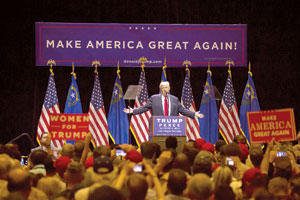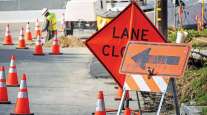Senior Reporter
Trump’s Infrastructure Plan Coming in Summer, Chao Says

This story appears in the May 1 print edition of Transport Topics.
The Trump administration is targeting early summer to unveil a long-term infrastructure bill, meaning that the president will not deliver on a campaign promise to put forth a plan within his first 100 days. But the White House provided some clarity on when the nation can expect to hear details on the promised 10-year, $1 trillion plan.
During the presidential campaign, on election night and in his inaugural address, Trump insisted he would present lawmakers with a plan to fix and modernize the transportation grid primarily through private-sector investments and minimal federal spending. The plan did not land by April 29 — Trump’s 100th day in office — but the administration believes it is an issue that could gain legislative traction.
“It’s something that I think both sides of the aisle, of both chambers, probably agree on,” White House Press Secretary Sean Spicer told reporters last week. “There’s a public-private partnership that could really benefit our infrastructure in terms of the financing piece of this. We’ll have further details on that moving forward, though.”
Transportation Secretary Elaine Chao in an April speech emphasized the summer timeframe for the plan’s unveiling, and the announcement was quickly endorsed by Republican transportation leaders on Capitol Hill.
At an April 26 hearing on freight rail policy, Rep. Bill Shuster (R-Pa.), chairman of the House Transportation and Infrastructure Committee, expressed confidence the “mother of all bills,” a term he used to refer to Trump’s infrastructure plan, would garner Democratic support and backing from House Freedom Caucus Republicans, who adhere to small government ideals. Shuster offered no specifics about the plan but noted that the bill will be wide-ranging.
“It’ll cover more than just the modes that we deal with in committee. It’ll have broadband — I think [that] will be in there — and the electric grid, power grid, will be part of it, plus many other things,” Shuster said enthusiastically. “I think it’s going to be a big bill. It’s something [where] we can find common ground across the aisle with our counterparts because when you talk about the infrastructure in this country, everybody knows we need to invest.”
During that hearing, Rep. Sam Graves (R-Mo.), chairman of the House Highways and Transit Subcommittee, told members of the National Association of State Highway and Transportation Unions at their conference that focusing on public- private partnerships, or P3s, as the primary funding option for infrastructure would not be a viable option.
“We have a lot of work to do, obviously,” Graves said. “I don’t think we can get there with P3s, and one of the biggest problems is that, for the investment private individuals put in, they’re going to want a return.”
Last week, the administration outlined a tax proposal that included a repatriation tax not linked to infrastructure funding. The proposal includes reductions in corporate and individual taxes, and it would eliminate various deductions. Critics of the plan said that it would benefit the country’s very wealthy.
The White House did not clarify what revenue from repatriation would be used for. Repatriating overseas profits with a low one-time tax had been touted by Republican leaders and a few Democrats.
The tax proposal and news about the upcoming infrastructure plan drew skepticism from several Democrats.
“The president was supposed to have a strong infrastructure bill coming in. The infrastructure bill is one of the biggest secrets in Washington, D.C., second only to the president not showing us his tax returns,” House Minority Leader Nancy Pelosi (D-Calif.) said April 23 on NBC’s “Meet The Press.”
“We need to create a sense of urgency. So we have a bridge collapse, and cars fall off of it, or whatever, and then it’s gone the next day. No one else is talking about it,” Rep. Brenda Lawrence (D-Mich.), a member of the House Small Business Committee, said at the NASHTU conference.
“For some reason, we have not had a sense of urgency in this country when it comes to investments,” she added. “We always find ways to do other things, like build a freaking wall, but we can’t seem to find the money and the urgency to invest in infrastructure.”
Industry stakeholders, from trucking executives to freight rail leaders, are urging the White House to deliver on Trump’s campaign promise of spending $1 trillion on infrastructure over 10 years. They note the American Society of Civil Engineers gave the country’s infrastructure a D+ grade.
“If we’re going to catch up to the deferred building and maintenance that’s been done, Congress needs to step up, the administration needs to step up, and there needs to be a long-term solution to how we’re going to pay for the infrastructure,” Ed Hamberger, CEO of the Association of American Railroads, told Transport Topics on April 25.




